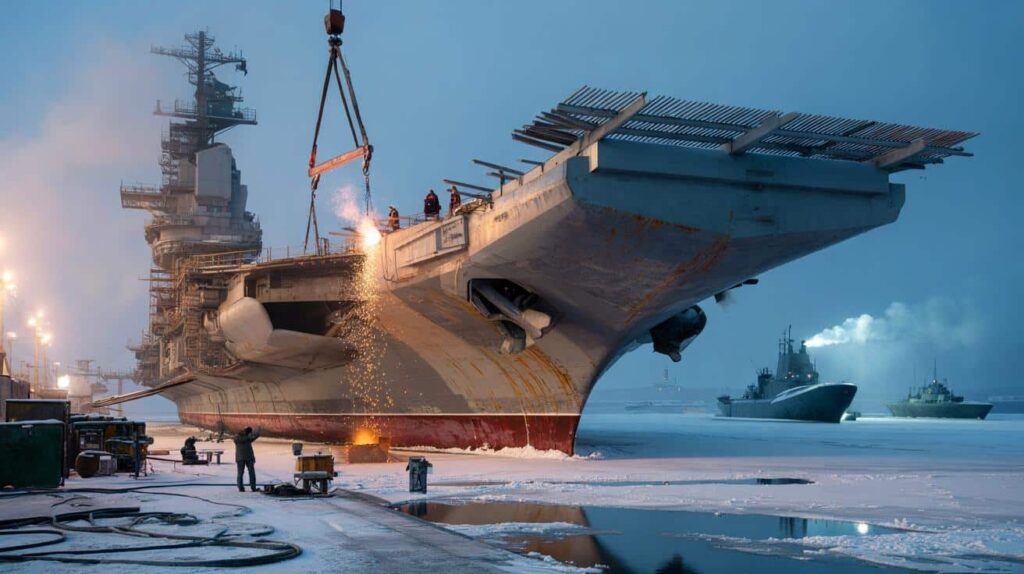The massive silhouette has turned into a source of speculation, a financial drain, a symbol that creates divisions even among sailors who once served on her. Is Moscow truly prepared to let go, or is it merely putting on an act? This question looms over the Barents like fog at dawn.
Years ago, I found myself on a frozen dock in Murmansk, my boots growing numb, observing sparks dance from a hull that appeared both formidable and oddly weary. Welders took breaks to sip tea from steaming mugs, then ducked back under tarps as if they were fixing an old apartment building that no one really wants to inhabit. The Kuznetsov’s deck seemed vacant and exposed, a layer of hope painted over weathered steel. We’ve all experienced that moment when the thing you’ve held onto “just a little longer” starts to hold you back.
*The vessel that refused to retire has become the vessel that can no longer be deployed.*
The rumor that winter would be its final season clung to my coat more tenaciously than the cold.
A ship out of time
Despite the myths, the core narrative is brutally straightforward: **the finances no longer add up.** Sanctions have disrupted supply chains, parts are hard to come by, and the Kuznetsov’s aging boilers consume heavy fuel as if it were 1991. The modernization process stretched from months to years, then became a blur on the calendar. Each repair uncovered another seam that needed mending. Eventually, a project meant to enhance prestige becomes a burden on policy.
The history reads like a cautionary tale. The floating dry dock PD‑50 sank in 2018, dropping a crane onto the flight deck. Fires erupted during refurbishments. Sea trials were promised, then delayed. The Syria deployment in 2016—its only combat cruise—resulted in the loss of two jets due to accidents and showcased optics Russia preferred to avoid: black smoke, arrestor failures, and harsh lessons on a global scale. Costs soared into the tens of billions of rubles. Deadlines shifted right. Confidence shifted left.
There’s a deeper rationale as well. Russia’s strategy favors submarines, long-range aviation, and land-based missile systems over deck-based air power. A2/AD “bastions” in the Arctic and Black Sea don’t require a ski-jump to be effective. Carriers necessitate air wings, catapult-like sortie patterns, and training pipelines that take time Moscow has allocated elsewhere. **Power projection no longer requires a deck.** It needs a launch button and a targeting solution. As priorities solidify, floating symbols become less significant.
How to read Moscow’s signals
Pay attention to the paperwork and the visuals. Budget allocations tell a story long before press releases do. If the carrier’s maintenance budgets flatten while submarine or drone funding increases, that’s a signal. Examine satellite imagery for activity: cranes, scaffolding, shore power connections, crew movements. Monitor NOTAMs and maritime advisories for sea trials that never materialize. One effective approach: create a simple checklist and update it monthly.
Ignore the noise. Grand declarations can serve as theater for domestic audiences. A refloated hull doesn’t mean a ship is ready. Don’t confuse paint with progress. Look for orders for spare parts for the air wing and new training rotations for deck crews; when those dwindle, ships fade away. It’s easy to cheer for the underdog hull. It’s harder to confront sunk costs. Allow empathy to coexist with the facts, not replace them. Let’s be truthful: not everyone does that every day.
“Warships don’t retire in press conferences; they retire in spreadsheets, workshops, and silence,” remarked a European naval officer who monitors Russian shipyards via satellite.
- Signals to observe: crew reassignment to other fleets.
- Removal of equipment from hangars and workshops.
- Quiet cancellations of contracts for jet spares or arresting gear.
- Inspections that keep getting postponed without new dates.
- Scrap tenders from regional shipyards, even smaller ones.
What it means if the Kuznetsov goes
Scrapping a flagship can appear as a retreat. However, it can also be a strategic move. **Scrapping can be a strategy, not a sign of surrender.** Releasing funds, personnel, and dock space generates momentum where it counts—submarines, cruise missiles, drones, artillery, electronic warfare. It also resets expectations. Russia has hinted for years at a “future carrier” on paper; retiring the Kuznetsov would implicitly acknowledge that the path back to blue-water aviation traverses a very long tunnel.
For NATO observers, the signal is mixed. On one hand, a significant piece of Russian naval theater exits the stage. On the other, a more focused fleet intensifies denial strategies near home waters. Shipyards that no longer have to care for a wounded giant can expedite the production of frigates, corvettes, and undersea assets. The narrative is less about romance and more about calculations. The world’s oceans won’t notice a missing silhouette in the same way headlines will. Yet navies will analyze the spreadsheets and adjust accordingly.
There’s a human aspect as well. Sailors who honed their skills on a smoky deck will age out recounting tales of sorties that nearly happened. Young engineers will design under different constraints. The Kuznetsov will persist in memes and museum photographs, not in wake turbulence. Perhaps that’s how a navy matures—by allowing a legend to fade into the historical records and constructing what it truly needs next.
| Key Point | Detail | Reader Interest |
|---|---|---|
| — | The cost calculus is shifting against the Kuznetsov as refits are delayed and sanctions take effect. | Understand why prestigious hardware can become a liability. |
| — | A shift in doctrine favors submarines, missiles, and shore-based air. | See how strategy—not just hardware—shapes fleet composition. |
| — | Signals to monitor: budgets, satellite imagery, spare parts orders, crew movements. | Follow the narrative yourself, beyond official announcements. |
FAQ :
- Is Russia officially scrapping the Admiral Kuznetsov?Moscow hasn’t made a definitive public statement, but the trajectory can be inferred from budgets, delays, and shipyard activities.
- Why is the carrier so difficult to maintain?Outdated boilers, limited parts due to sanctions, complex arresting systems, and a maintenance backlog that escalates costs.
- Could Russia construct a new carrier instead?Conceptual designs exist, but funding and industrial capacity for a modern carrier and air wing are the real challenges.
- Does losing a carrier diminish Russian power projection?In the long term, yes; in home waters, missiles, submarines, and land-based aviation fulfill much of that role.
- What should we monitor next?Sea trial notifications, aircraft spare parts procurement, personnel reassignments, and any scrap or mothball contracts in the north.








